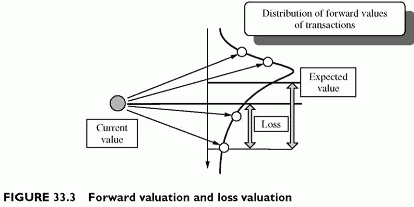Credit Risk Drivers
Category: Risk Management in Banking
KMV Portfolio Manager uses the asset value of firms as credit driver. CPV uses country-industry economic variables as risk drivers. Consequently, correlations between the individual credit events result from their dependence on common factors influencing asset values of firms or economic indexes driving the default probabilities. The correlation building of portfolio models uses one of these two approaches. Other models use empirical fits of ratings or defaults to observable attributes, but they do not assume any causal model between these attributes and the modelled ratings or default rates.
Exposure at Default and Recoveries
Most future exposures are uncertain as well as recoveries under default, hence the definitions of the Exposure At Default (EAD) and the loss given default (Lgd) for measuring losses due to credit risk. Exposures at default are future and uncertain, as well as recoveries.
For the banking portfolio, only some contractual exposures are projected. Others require projections, usually based on business rules and assumptions. Exposures at default are time profiles of exposures, either contractual or expected.
For the trading portfolio, the holding period view prevails. Rules stipulate that credit risk is the risk independent of market movements, or specific risk, as defined when discussing market risk. For derivatives, it is not possible to easily trade them, making it necessary to revert to the hold to maturity view of the exposure. Market-driven exposures of derivatives are defined as the time profile of peak positive exposures of instruments during their life, at a given confidence level. It is a common practice to transform uncertain exposures of derivatives into loan equivalents for the horizon considered for credit risk. This bypasses uncertainty, however, because both exposure uncertainty and credit risk interact for determining random losses.
This is a limitation of existing portfolio models. Most models do not really capture exposure uncertainty, except through a judgmental assessment of exposure at default. None of the current versions of portfolio models accommodates derivative exposure risk. All models use the loan equivalent technique to capture derivative exposures, leaving for end-users the definition or the calculation, when adequate tools are available, of this loan equivalent.
Recoveries are a specific issue in credit risk because losses are net of any recovery. Whether or not the borrower defaults, we get back this fraction. The New Basel Accord allows recognition of some reasonably certain recoveries for alleviating capital charge. To some extent, it is possible to model recoveries according to the source of recoveries. In subsequent chapters, we show that some collateral-based transactions have a measurable risk, that the default probability of a primary borrower benefiting from third-party protection derives from the double default rule, or joint default of borrower and guarantor. In other cases, recoveries rely on expert judgment, for assigning a recovery rate. A recovery rate is similar to a facility rating, because it characterizes the facility risk, rather than the obligors risk, except that it quantifies the risk.
Portfolio models do not get into such details. They use an assigned recovery rate by facility, considered as an input. This is a drawback of models, because recovery is one of the major factors limiting losses, and recognized as such by the regulatory bodies. The only portfolio model that includes recovery uncertainty is KMV Portfolio Manager, which uses a beta distribution for the loss under default, in percentage terms, whose mode is the user-defined expected value.
Credit Risk Valuation
Book value exposures do not change with risk migrations. Models ignoring such value changes are default-only models. CreditRisk+ models defaults only. Marking-to-market values of loans imply that these values change when risk changes. The process uses the basic discounted cash flow model for valuing traded or non-traded facilities, using as discount rates the market risk-free rate plus the credit spread corresponding to the credit risk of the facility. This valuation captures the full effect of risk migrations on value rather than running in default mode only. Techniques for valuing migration range from modelling the distribution of credit risk drivers, such as asset values of firms and economic variables, to the usage of migration matrices, based on historical data, providing the frequencies of migrations for each of the final risk classes. Both expected value and value percentiles characterizing the standalone Value at Risk (VaR) of facilities derive from the distribution of values obtained through any one of these techniques (Figure 33.3).
Mark-to-market is only an option for modelling migrations of banking exposures. Marking-to-market makes explicit value changes when there are migrations across risk classes. KMV Portfolio Manager, Credit Metrics and CPV are full valuation models. KMV Portfolio Manager models migration by the distribution of the asset values at the horizon. Credit Metrics uses the same technique combined with transition matrices. CPV also uses the transition matrices, linking migration to the economic-industry variables influencing the default rates.

